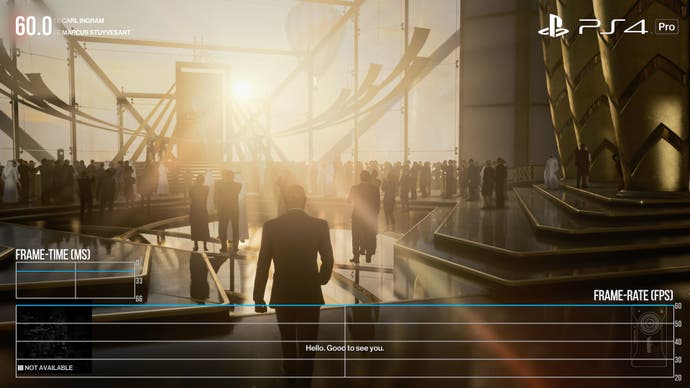Hitman 3 tech review: the Glacier Engine shines on next-gen consoles
But last-gen hardware isn't left behind.
Traditionally, the cross-gen period - the awkward transition from one set of consoles to the next - hasn't really worked out. There's the sense that the next-gen versions aren't necessarily everything they could be, while the software served up to owners of the older consoles often verged on the unplayable. But as move from PS4 to PS5, from Xbox One to Xbox Series, it's clear that we're seeing something very different this time around. IO Interactive's Hitman 3 shows that cross-gen can actually work out just fine, and there's the feeling that prior generation consoles are being pushed closer to their ultimate limits, while simultaneously, massive gains are achieved when playing on PS5 and Xbox Series X.
Of course, Hitman 3 is a game with additional interest for us, because IO's excellent Glacier Engine has evolved, bringing impressive new features into the technology - while at the same time back-porting those innovations to the entirety of the Hitman trilogy. It's to IO's credit that with each Hitman release, and with each iteration of Glacier, existing content has been ported to the latest game, benefitting from the engine upgrades. It's doubly useful for Hitman 3 played on a next-gen console because the baseline improvements are so profound, it's effectively both a new game and a next-gen remaster of the older releases.
So how has Glacier moved on? The new maps are truly effective showcases for some of the new technology and the initial Dubai mission is a beautiful debut for a range of effects - foremost amongst them the arrival of a remarkable implementation of screen-space reflections. The environment is packed with reflective surfaces including metal and glass, presented in a brightly lit manner that would make imperfections obvious, while Hitman continues to look pristine. Of course, there are limits to SSR - off-screen detail can never be reflected - but Glacier has some interesting tricks up its sleeve for enhancing the effect. So, for example, the game's signature crowds are reflected too, but it seems that these are 2D-sprite like 'imposters' to save on processing resources, while still looking very effective.
All of this is achieved by building upon the existing Glacier tech, so SSR is bolstered with pleasing cubemaps (static light probes with textured surfaces that can be used to mimic reflections) along with the render-to-texture feature that debuted in Hitman 2. Here, the scene is effectively rendered twice, the secondary viewpoint mapped to a texture to deliver a 'proper' reflection. It's heavy on resources, it needs to be applied sparingly and typically it only works on flat, mirror-like surfaces - but crucially, it looks good. In time we'd hope to see full ray tracing alternatives, but for now, it does the trick - and it works on all supported consoles.
If we skip ahead to a later mission, we're treated to another visually striking scenario - a rainy Chinese city at night. This map showcases another new string to Glacier's bow through the simulation of rain and wet surfaces. Raindrops realistically play off 47's coat while a nice droplet effect is crafted to represent puddles. When you make your way to the stage's main street, the combination of reflections and neon signs delivers a dark atmosphere not unlike Hitman Contracts - the original third Hitman game. It's dark, beautiful and really showcases the engine in a new light.
It's also interesting to see how the new additions to the Glacier Engine feed back into the legacy Hitman content. The classic Paris stage from the original Hitman still looks wonderful to this day, but the marble flooring effect now benefits from the new SSR pass - and the content manages to run better than the original game on Series X running under backwards compatibility. It also looks as though IO has revisited the way that trees and foliage are rendered. I'm not sure there's actually much in the way of improvement as such (at least on the older maps) but it's definitely a change there. Other differences are less profound, but show an eye for detail - a static curtain may now possess cloth physics animation, for example.
Overall though, it's the retrofitting of screen-space reflections that shows the biggest change - that, and performance of course. On the vanilla last-gen machines, Hitman titles could be run capped to 30fps or unlocked, while Xbox One X also benefitted from 4K quality and 1440p performance modes. In the shift to Hitman 3, all last-gen machines are capped at 30fps and there are no quality and performance modes (bar one exception, which I'll address shortly). On the one hand, Hitman 3 possesses engine upgrades and ambitions in the content that justify the limitations. On the other, Xbox One X owners in particular may prefer to retain Hitman 2 for its ability to access legacy missions at frame-rates above 30fps.
The outlier here is PS4 Pro, which curiously offers both 1440p30 and 1080p60 modes. We tried the latter on the initial Dubai stage and found that while it wasn't as smooth and consistent as Xbox Series S's 1080p60 output (though curiously, shadow quality is higher), it was close enough to 60fps to make it the preferable way to play on last-gen PS4 systems. PlayStation owners also get the chance to play every mission from the entire trilogy in VR too. The compromises are self-evident, but it works. It's just a shame that to access VR on PlayStation 5, you need to run the PS4 code, doubling up on installs. It's unfortunate but it's the way that Sony chooses to set up the system, and there's nothing IO could really do here.
All of which leads us on to the actual next-gen difference - why we prefer to play Hitman 3 on PlayStation 5 or Xbox Series X. First of all, the bump up to full 4K (or 1800p, in the case of PS5) definitely plays a role. In the past we've talked about how image reconstruction techniques and dynamic resolution scaling make the need to deliver 8.3m pixels per frame less of a necessity, and that's definitely the case - especially in the age of temporal anti-aliasing. However, the Glacier Engine concentrates on delivering a pristine presentation that does not rely so heavily on heavy post-processing or temporal accumulation techniques to achieve its goals. Hitman 3 focuses on clean lines and well-defined spaces, where a higher resolution definitely helps. This requires brute force horsepower and that's what the new consoles deliver. Then there's the 60 frames per second update rate, and the way that a nigh-on unwavering 60fps adds further to the pristine presentation.

Beyond that, Hitman 3 focuses on refinement. Xbox Series X and PlayStation 5 have access to more system memory that any of their last-gen counterparts, so the equivalent of PC's ultra level textures are deployed. This is supplemented with a move to 8x anisotropic filtering, which is a nice step up from the 4x seen on the last-gen versions of the game. Shadow quality is also improved, specifically on Xbox Series X, which stands alone from all the console versions in matching PC's high preset.
And in summary, that's why Hitman 3 works as a cross-gen title. Unlike the messy transition periods we've seen in the past, there are still enhancements delivered for the last-gen consoles and while we've lost the unlocked frame-rate on most of the older systems, performance is still consistent overall. I am baffled as to why Xbox One X owners don't get access to an unlocked frame-rate mode (on paper, it should run even better than PS4 Pro) but ultimately I don't feel like last-gen users get shortchanged. Meanwhile, it's clear that next-gen consoles get a more refined, smoother and prettier experience - even if there is the sense that Hitman 3 isn't specifically targeting the capabilities of the new hardware. But when a game looks as good as this, runs as well as this and features some superb new missions, it's difficult to complain.
And there is one more aspect I'd like to highlight - loading times. We talked about this a touch in our platform comparison piece, but we're looking at sub-ten second loading times for all missions. In one specific case, a circa ten second mission load on Series X can take around 59 seconds on One X - and in terms of overall quality of life, that's an extreme upgrade that's well worth having, especially when it comes to reloading after death. It's the final coat of polish on what is already a gleaming package for next-gen users. Hitman 3 works for me on all the consoles I tested it on, but Series X and PS5 in particular are a class apart by virtually every measurable metric.











